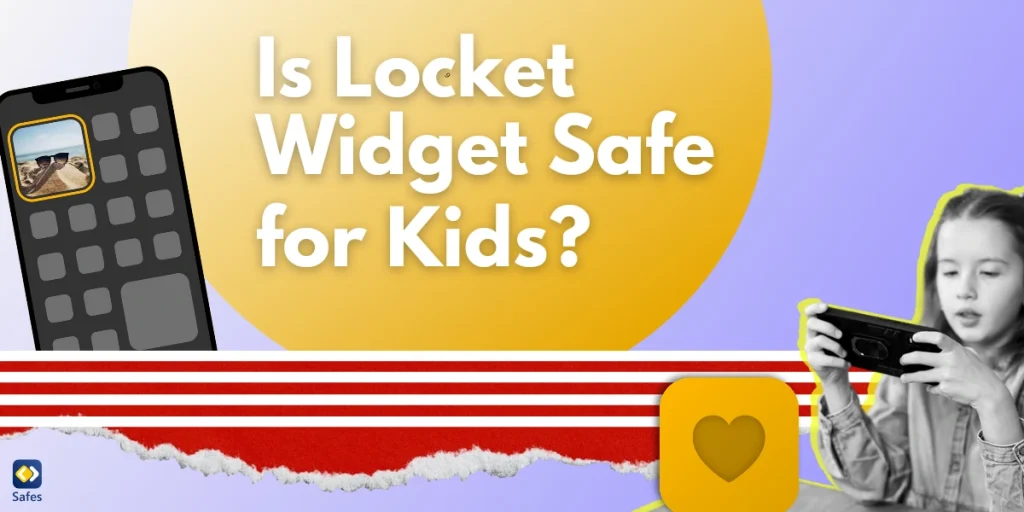With the rise of social apps geared toward real-time photo sharing, Locket Widget has emerged as a popular choice among teenagers. The app allows users to send and receive photos directly to friends’ home screens, offering an instant and intimate way to stay connected. But with privacy concerns and the potential for inappropriate content, many parents wonder: is Locket Widget safe for kids? In this blog, we’ll examine how Locket Widget works, its privacy features, potential risks, and steps parents can take to ensure safer usage for their children. Here’s our Locket Widger parent review.
What Is Locket Widget?
Locket Widget is an app on Android and iOS designed to deliver real-time photo updates from friends and family directly to a user’s phone screen. The app’s concept centers on simplicity—users can add friends, snap a quick picture, and it instantly appears on their friends’ widgets. By keeping a constant flow of photos directly on the home screen, it allows a new form of communication that is more spontaneous than traditional social media. But is Locket Widget safe on iOS and Android devices?
Key Features of Locket Widget:
- Real-Time Sharing: Photos taken on the app are sent directly to friends’ home screens, offering a personal touch to updates.
- Simple Friend Network: The app limits connections to people the user has added as friends, ensuring that photos are shared only among approved contacts.
- Home Screen Display: By being visible directly on the home screen, photos from close friends or family members are always within easy reach.
This unique format has made Locket Widget a popular choice for teens who want a quick way to stay in touch without the more public visibility of apps like Instagram or Snapchat.
Privacy and Data Collection
One of the primary concerns with any app, especially one that targets teens, is data privacy. According to the app’s privacy policy, Locket Widget collects certain personal data, including:
- Contact Information: The app requires access to contacts to facilitate friend connections, which means it will have access to your child’s phone contacts.
- Photos and Media Files: Given the nature of the app, it requires permission to access the camera and stored images, which some parents might find concerning.
- App Usage Data: Locket Widget also collects usage data, including how often the app is accessed and which features are used most frequently.
Though Locket Widget promises not to sell user data to third parties, it’s important to understand that certain data collection is inherent to its functioning. Parents should familiarize themselves with the privacy settings on their child’s device and talk about what kinds of photos are safe to share.
Is Locket Widget Safe for Teenagers and Kids?
Locket Widget’s streamlined design and limited social network make it safer than some mainstream social media apps. However, with oa few potential risks remain for younger users:
- Privacy Concerns: Since Locket Widget has access to both contacts and camera, there’s a risk that sensitive information could be shared unintentionally. Parents should be aware that the app requires these permissions and ensure they are comfortable with this level of access.
- Inappropriate Content: While the app is intended for sharing photos among friends, teens might feel compelled to take and share photos impulsively, potentially leading to the sharing of inappropriate images. Given the direct home screen display, there’s little buffer to reconsider images before they’re sent.
- Location Tracking: Though Locket Widget doesn’t explicitly collect location data, images taken in familiar locations can inadvertently share location information, such as school or home settings, through contextual clues in the background.
- Limited Parental Controls: Unlike more established social media apps, Locket Widget doesn’t have built-in parental control features. This absence means parents won’t have direct oversight of their child’s activity, so they’ll need to take extra steps to monitor usage.
How to Ensure Safe Usage of Locket Widget
Despite these potential concerns, there are ways for parents to help ensure a safer experience for children using Locket Widget:
- Set Ground Rules for Sharing: Educate your child about safe photo-sharing practices. Explain the risks of sharing sensitive or identifying images, and encourage them to think before sending each photo.
- Limit Contacts: Encourage your child to add only close friends and family members, reducing the chance that photos will fall into the wrong hands. Discuss the importance of not adding unknown people.
- Review App Permissions: Regularly review the app’s permissions on your child’s device. Limit permissions that feel unnecessary, and use screen time controls to set usage limits if necessary.
- Use Parental Control Apps: Apps like Safes Family offer tools for parents to monitor social media usage and set boundaries around screen time. Safes Family allows you to track which apps your child is using most frequently and provides options for controlling app access, making it a valuable tool to enhance digital safety.
Pros and Cons of Locket Widget
Here are the pros and cons of using Locket Widget
Pros:
- Real-Time Connection: Locket Widget offers a fun way for kids to stay connected with close friends in real-time.
- Simplified Design: Unlike traditional social media, the app doesn’t have comments, likes, or shares, which reduces social pressure and encourages authentic sharing.
Cons:
- Privacy Risks: By requiring access to contacts and camera, the app has access to potentially sensitive information.
- Lack of Parental Controls: Without in-app parental controls, it’s difficult for parents to monitor usage directly.
- Potential for Impulsive Sharing: The immediacy of the app’s sharing feature could lead to the impulsive sharing of inappropriate images.

General Ground Rules for Photo Sharing for Teenagers
When it comes to setting ground rules for teenagers around photo sharing, it’s essential for parents to foster both awareness and responsibility around oversharing on social media. Here are some useful guidelines:
- Discuss Privacy and Permanence: Explain the permanence of online sharing, even if a photo is “deleted.” Teens should understand that once an image is shared, it can be saved, screenshotted, or distributed without their control. Encourage them to consider if the image is something they’d be comfortable with anyone seeing, including family or future employers.
- Set Boundaries for Content: Agree on specific boundaries for what types of photos are acceptable and age-appropriate content to share. Photos that are respectful, avoid sensitive locations, and don’t reveal personal information are generally safer. Discourage any images that might embarrass or compromise themselves or others.
- Limit Audience and Use Privacy Settings: Encourage them to only share photos with close friends or trusted contacts and use privacy settings to control who can view their images. Avoid public sharing or sending photos to people they don’t know well.
- Avoid Geo-Tagging and Sensitive Backgrounds: Advise against location tagging, especially near home or school. Additionally, be mindful of what’s in the background of photos, as these details can reveal information about their location or personal life.
- Think Before Posting: Introduce the concept of “pause before you post.” Teens can avoid impulsive sharing by taking a moment to consider if the image is appropriate. Practicing this habit can reduce the chances of sharing something they might later regret.
- Discuss Potential Risks: Be open about the risks of sharing photos online, such as potential cyberbullying, harassment, or exploitation. Frame this conversation as a way of looking out for them rather than limiting their freedom, helping them understand that these boundaries are meant to keep them safe.
- Encourage Open Communication: Make sure your teen feels comfortable coming to you if they have questions or if an issue arises. Let them know they won’t be judged for mistakes and that their safety is the priority.
Setting these guidelines and having ongoing conversations can help teens enjoy sharing photos responsibly while protecting their privacy and well-being online.
Potential Risks of Photo Sharing
In case you need examples to explain the risks of photo sharing to strangers for your teenager, use these:
- Privacy Invasion: Once photos are shared online, they are often out of the original sender’s control. Friends, followers, or others can save, screenshot, or forward images, making it hard to ensure privacy. Photos might be used without permission, possibly leading to unwanted exposure.
- Cyberbullying and Harassment: Teenagers who share photos, especially on public or semi-public platforms, can become targets for cyberbullying. Photos can be altered, shared with harmful intent, or used to mock or harass the teen, causing significant emotional distress. Even when there is no harassment or cyberbullying, teenagers should be aware of the the peer pressure of social media.
- Location Exposure and Stalking: Many images contain geotags or contextual clues that can reveal a teen’s location, making them vulnerable to unwanted attention. This information can unintentionally expose them to stalking or harassment, especially if the photo indicates a regular hangout spot or reveals their home address.
- Unwanted Contact and Grooming Risks: Sharing personal photos online can attract strangers or older individuals with malicious intent. Predators might use seemingly innocent photos to initiate contact or build rapport with teens, putting them at risk of grooming or exploitation.
- Impact on Future Opportunities: Photos shared now can impact a teen’s future, as college admissions officers or potential employers may view these images. Inappropriate photos or those suggesting risky behavior might harm their reputation or chances in educational or professional opportunities.
- Emotional and Psychological Impact: Many teens feel pressure to portray a “perfect” image online, which can lead to feelings of inadequacy or low self-esteem. Receiving negative comments or few likes on photos can also cause emotional distress, affecting their mental health and body image.
These risks highlight the importance of helping teens understand safe sharing practices, setting boundaries, and encouraging them to think carefully before sharing images online.
Conclusion
While Locket Widget provides an innovative way for teens to stay connected, it has privacy and safety limitations that parents should understand before allowing its use. By setting clear expectations, monitoring usage, and exploring privacy settings, parents can help their children use Locket Widget more safely. However, for those who prefer apps with built-in parental controls, several alternatives offer similar features with added oversight capabilities.
In today’s digital landscape, staying informed and proactive about app safety is key to helping children enjoy a safer online experience. Safes Family’s parental control features can help you keep track of your child’s social media usage, set screen time limits, and ensure a safe digital experience. Try Safes Family for free and explore ways to keep your family’s online interactions secure!




